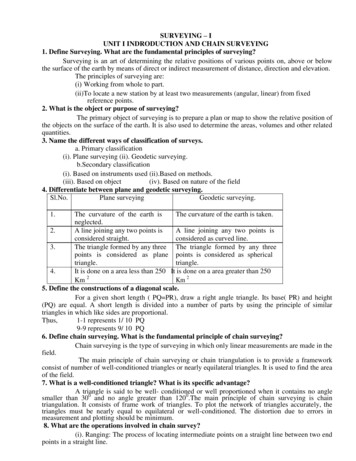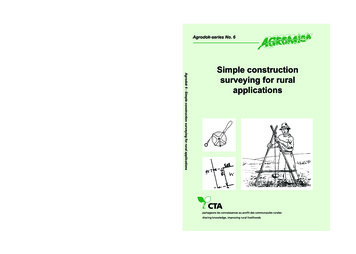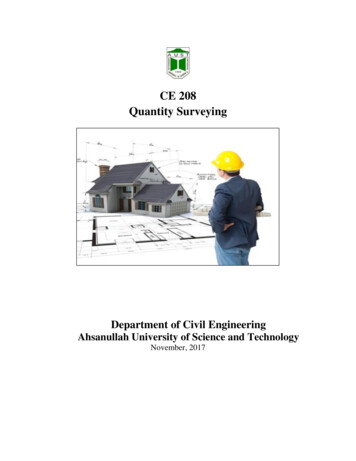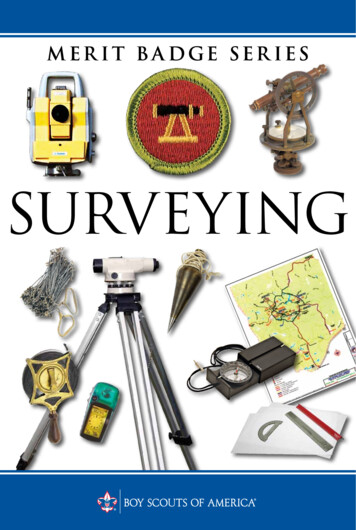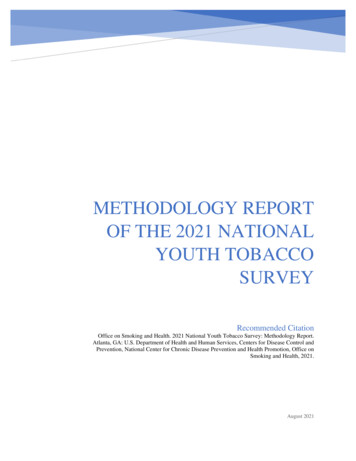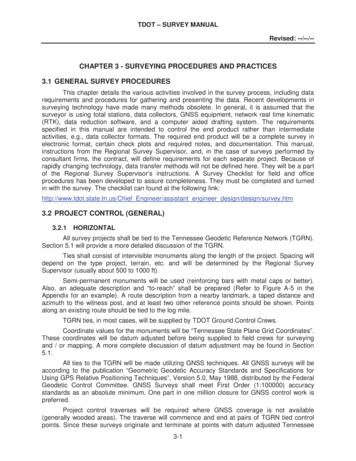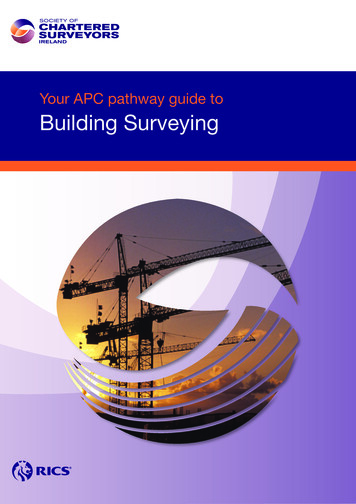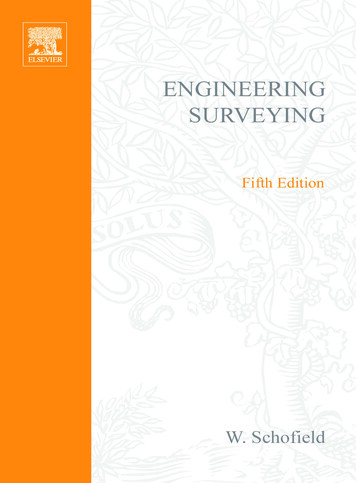
Transcription
MDHSMethods for the Determination ofHazardous SubstancesHealth and Safety Laboratory100Surveying, samplingand assessment ofasbestos-containingmaterialsJuly 2001CONTENTSIntroduction2Overview of requirements for surveying andsampling 3Aim, purpose and type of surveySurvey planning5Health and safety risksSurveying77Bulk sampling strategy9Bulk sampling proceduresAssessment1517Documentation19Quality assurance proceduresReferences32020Acknowledgements21Annex 1: What ACMs look like and where to findthem 24Annex 2: Example of a survey and samplingequipment checklist 43Annex 3: Asbestos warning label144
INTRODUCTION1 This MDHS sets out how to survey workplacepremises for asbestos-containing materials (ACMs)and how to record the results in a usable form. Italso gives advice on how to recognise and samplesuspected ACMs. The MDHS has been produced aspart of guidance issued by the Health and SafetyExecutive for people carrying out surveys. It will alsobe of interest to those who commission surveys.Regulations monitor the condition of asbestos andpresumed asbestos materials; assess the risk of exposure from the asbestosand presumed asbestos materials anddocument the actions necessary to manage therisk; and take steps to see that the actions above arecarried out.To manage the risk from asbestos-containingmaterials you will need to:2 The Health and Safety at Work etc Act 19741requires an employer to provide a safe workplace.Work with asbestos is covered by its own set ofregulations – the Control of Asbestos at WorkRegulations (CAWR).2 There are duties to prepare arisk assessment and to make written arrangementsto protect those at risk in the Management of Healthand Safety at Work Regulations 1999,3 and tomaintain workplace buildings/premises to protectoccupants and workers under the Workplace(Health, Safety and Welfare) Regulations 1992.4Arrangements to deal with asbestos duringrefurbishment may also be required by theConstruction (Design and Management) Regulations1994.5 It is intended that CAWR6 be amended byintroducing a specific duty to manage the risk fromasbestos-containing materials in premises. Thisspecific duty will be supported by an approved codeof practice (ACOP) and associated guidance.Managing asbestos3 The new regulation will create an explicit duty toassess and manage the risks from asbestos inpremises. The risks will vary with circumstances,ranging from normal occupation of a building to therepair, refurbishment and demolition of thepremises, and they will each need to be assessed.This assessment will be used to produce amanagement plan which details and records theactions to be undertaken to manage and reduce therisks from asbestos. The broad requirements onemployers are to: take reasonable steps to determine the locationof materials likely to contain asbestos; presume materials to contain asbestos, unlessthere are good reasons not to do so; make and maintain a written record of thelocation of the asbestos and presumedasbestos materials;2 keep and maintain an up-to-date record of thelocation, condition, maintenance and removal ofall asbestos-containing materials on thepremises; repair, seal or remove, if there is a risk ofexposure due to its condition or location; maintain it in a good state of repair andregularly monitor the condition; inform anyone who is likely to disturb it aboutthe location and condition of the material; have arrangements and procedures in place, sothat work which may disturb the materialscomplies with CAWR; and review the plan at regular intervals and makechanges to the plan and arrangements ifcircumstances change.Health and safety issues4 Surveying and sampling ACMs can give rise toexposure to asbestos and is covered by CAWR,which require an assessment and plan of work to bemade, setting out the control measures andpersonal protective equipment (PPE) to be used. Italso requires that adequate information, training andrefresher training have been given to the samplingpersonnel. Sampling ACMs is, however, exemptfrom the Asbestos (Licensing) Regulations (1983) asamended,7 but is covered by the CAWR ACOP onunlicensed work.8 As other hazards may be present,such as working at heights and electrical hazards, arisk assessment will need to be carried out beforecommencing work on site (see paragraph 25). Itshould include any safety aspects and record anysafety protocol to be observed on site. Firealarm/evacuation procedures should be included.
OVERVIEW OF REQUIREMENTS FORSURVEYING AND SAMPLING5 Anyone undertaking surveys or samplingshould: have appropriate training and experience; be able to demonstrate independence,impartiality and integrity; and have an adequate quality assurance procedure(see paragraphs 67-69).Appropriate training, for example, is provided bycourses organised through the British Institute ofOccupational Hygiene (BIOH) (see paragraph 67 forcontact information).Several of the management options apply to allACMs and are required by CAWR. Others areappropriate for ACMs which have a high material orrisk assessment score. Guidance on riskassessment and the management of asbestos willbe available from HSE. Advice from the Departmentof the Environment, Transport and the Regions(DETR) is also available.9Asbestos surveys7An asbestos survey has three main elements: firstly, it must as far as reasonably practicablelocate and record the location, extent andproduct type of any presumed or known ACMs; secondly, it must inspect and recordinformation on the accessibility, condition andsurface treatment of any presumed or knownACMs; thirdly, it should determine and record theasbestos type, either by collectingrepresentative samples of suspect materials forlaboratory identification, or by making apresumption based on the product type and itsappearance etc.Asbestos management programmes6In order to have an effective asbestosmanagement programme, it is necessary toestablish clear lines of responsibility for theprogramme’s management and implementation. Asurvey of the premises must be undertaken to locateand assess the ACMs. The results of the surveymust be recorded in an easily retrievable form,which can then be used to make a risk assessmentand draw up a management plan. The managementplan may include some or all of the followingoptions:This information must be held in a suitable(upgradable) form and should be accessible to andunderstandable by all relevant personnel. clean up debris;Material assessment repair; encapsulate (paint or seal); enclose; remove; maintain and update log of ACMs; monitor condition (applies to all presumed oridentified ACMs);8 The purpose of the material assessment is toestablish the relative ability of various types ofACMs to release fibres into the air, should they bedisturbed. The type of fibre is also taken intoaccount. This assessment can be carried out as anintegral part of the survey, as it requires noknowledge about the building use etc. A simple fourparameter additive algorithm is used to assess thelikely magnitude of release from the material, givena standard disturbance. This is evaluated using fourcategories: high, medium, low and very low. restrict access/isolate; label or colour code; inform; train; define and use safe systems of work; operate a permit-to-work system.AIM, PURPOSE AND TYPE OF SURVEYAim and purpose9 The type of survey undertaken may vary,depending on the aim and purpose for which it is tobe used. Surveys before demolition andrefurbishment will continue to be required underCAWR and the CDM regulations.5 However, it isanticipated that most surveys will be undertakeninitially to comply with the duty to manage asbestos3
in premises. In these cases, the aim of an asbestossurvey is, as far as reasonably practicable, to locateand assess all the ACMs present in the building andits purpose is to present the information collected ina way which allows the employer to manage therisk. In situations where a surveyor is used, the aim,purpose, type of survey and report format requiredshould be clearly established in the original invitationto tender, or agreed with the client at a preliminarymeeting or site visit before starting the survey. Oneof the main issues is to decide when samples shouldbe taken to prove that ACMs are not present.Presumption or identification of ACMs10 An experienced, well-trained surveyor, familiarwith the range of asbestos products, can usually, byinspection alone, say that a material can be‘presumed’ to contain asbestos. This presumptioncan only be tested by laboratory analysis ofrepresentative samples of the material. A lowmagnification stereo microscope examination of thesample followed by polarised light microscopy (PLM)of selected fibres, as outlined in MDHS 77,10 is themost widely used and cost-effective method incurrent use. In the absence of analytical evidence,many non-asbestos materials will also be presumedto contain asbestos, unless there is other strongevidence to support a reasoned argument that theyare highly unlikely to contain asbestos.11 This therefore creates two levels ofpresumption: one where there is a 'strongpresumption' that the material does containasbestos but a laboratory identification has not beenundertaken to confirm this; and a default situationwhere it must be 'presumed' to contain asbestosbecause there is insufficient evidence to suggestthat it is not an ACM. An example of a 'strongpresumption' would be thermal insulation on a pipewhere fibres are clearly visible and have theappearance of asbestos but no sample analysis hasbeen undertaken. Where similar construction existsand laboratory analysis of one of the materials hasconfirmed the presence of asbestos, there is astrong presumption that the other similar materialsalso contain asbestos. Materials where no asbestosfibres are visible but asbestos is known to havebeen commonly used in the manufactured productat the time of installation (eg floor tiles, ceiling tilesand insulating boards) will be presumed to containasbestos. A reasoned argument to suggest that amaterial does not contain asbestos would be:4 non-asbestos substitute materials werespecified in the original architect's/quantitysurveyor’s plans or in subsequentrefurbishments; the product was very unlikely to containasbestos or have asbestos added (egwallpaper, plasterboard etc); post-1985 construction (for amphiboleasbestos-containing materials such as asbestosinsulation board, see Table 1); post-1999 construction (some chrysotileproducts were prohibited in 1993 and nearly allwere prohibited in 1999).12 The conclusion that ACMs are not presentcannot always be easily reached. The regulationsrequire that reasonable steps are taken. It may insome circumstances not be reasonable to decidewholly on age and/or original specifications, whichmay have been circumvented during theconstruction of the building. There are alsoexamples of poor removal practice leavingasbestos-containing debris and residues, and areaswhere asbestos has been removed previously willneed to be inspected.Type of surveyThere are three types of survey referred to in thisMDHS.Type 1: Location and assessment survey(presumptive survey)13 The purpose of the survey is to locate, as far asreasonably practicable, the presence and extent ofany suspect ACMs in the building and assess theircondition. This survey essentially defers the need tosample and analyse for asbestos (or the absencethereof) until a later time (eg prior to demolition ormajor refurbishment). The duty holder bearspotential additional costs of management for somenon-asbestos-containing materials. All areas shouldbe accessed and inspected as far as reasonablypracticable (eg above false ceilings and insiderisers, service ducts, lift shafts, etc) or must bepresumed to contain asbestos. Any material whichcan reasonably be expected to contain asbestosmust be presumed to contain asbestos, and where itappears highly likely to contain asbestos, thereshould be a strong presumption that it does. Allmaterials which are presumed to contain asbestosmust be assessed.
Type 2: Standard sampling, identification andassessment survey (sampling survey)14 The purpose and procedures used in thissurvey are the same as for Type 1, except thatrepresentative samples are collected and analysedfor the presence of asbestos. Samples from eachtype of suspect ACM found are collected andanalysed to confirm or refute the surveyor’sjudgement. If the material sampled is found tocontain asbestos, other similar homogeneousmaterials used in the same way in the building canbe strongly presumed to contain asbestos. Lesshomogeneous materials will require a greaternumber of samples. The number should be sufficientfor the surveyor to make an assessment of whetherasbestos is or is not present. Sampling may takeplace simultaneously with the survey, or as in thecase of some larger surveys, can be carried out as aseparate exercise, after the Type 1 survey iscomplete.Type 3: Full access sampling and identificationsurvey (pre-demolition/major refurbishmentsurveys)15 This type of survey is used to locate anddescribe, as far as reasonably practicable, all ACMsin the building and may involve destructiveinspection, as necessary, to gain access to allareas, including those that may be difficult to reach.A full sampling programme is undertaken to identifypossible ACMs and estimates of the volume andsurface area of ACMs made. The survey is designedto be used as a basis for tendering the removal ofACMs from the building prior to demolition or majorrefurbishment so the survey does not assess thecondition of the asbestos, other than to note areasof damage or where additional asbestos debris maybe expected to be present.16 Although different types of survey can bespecified and used depending on the circumstances,it is important that the building owner, employer andthe surveyor know exactly what type of survey is tobe carried out, what the specifications for each typeare, and in which areas they are to be used. It isrecommended that the type of survey usedconforms to a standard (eg this MDHS), otherwiseinterpretation of the survey reports will be difficultand the management plan produced may notadequately minimise the risks involved. It is possiblethat at larger premises a mixture of survey types willbe appropriate – eg a boiler house due fordemolition will require a Type 3 pre-demolitionsurvey, while offices at the site may only have aType 1 presumptive survey. Similarly, a system-builtproperty may start with several Type 2 surveys, butother similar premises may be evaluated using aType 1 survey. Therefore it is important that there isa clear statement and record of the type of surveysthat are to be carried out, including the reasons fortype selected, where they are to be carried out, andan estimate of the number of samples to becollected.SURVEY PLANNINGProcedure17 Once the type of survey has been established,it is important to gather information and plan thesurvey. Survey planning should include the followingfive steps: preliminary site meeting and walk-through; desk-top study to plan survey; survey plan (including details of samplingstrategy, if appropriate); risk assessment for the conduct of the survey;and specification of the method for recording andpresenting data.At some sites it may not be necessary or possible toinclude all of these steps (eg small premises, firedamaged premises and pre-purchase surveys etc).Preliminary site meeting and walk-through18 If a third party is carrying out a survey for theemployer, a preliminary meeting is important toestablish how to record and use the results of thesurvey, so the employer can manage the risk. It isalso an opportunity to explain further the type ofsurvey and assessments which will be undertaken.Every site will have its own specific problemsrelating to safety issues and hazards, the availabilityof original and up-to-date plans, entry limitations tocertain areas etc. Whenever possible, currentaccurate plans of the building and the floor layoutshould be made available at an early stage. Ifcurrent or older plans are not available, a sketchplan will need to be made. All plans should bechecked for accuracy. These plans will be used torefer to and record the whereabouts of any suspectmaterial and the location of any samples taken foridentification. They should also be used to locateand record any sensitive or restricted areas andhazards.19 A walk through the site should be made with aperson who knows the premises which are to besurveyed. The purpose is to get a better overall5
picture of the site and the problems involved. Thewalk-through can be used to check that any siteplans are up-to-date and room numbering/coding isadequate. It also allows any specific hazards whichthe survey personnel may encounter to berecognised and discussed to minimise any risks.Potential problems for access to ceiling voids andcrawl spaces can also be assessed, along with otherpotential sampling problems (eg sampling only whenthe area is otherwise unoccupied, materials ordecorations which cannot be disturbed, labelling ofsample locations, future placement of asbestoswarning labels, measures used to reduce dustrelease and clean-up, etc).Desk-top study to plan survey20 The aim of the desk-top study is to gatherinformation on the types, construction and ages ofpremises to be surveyed and current or formerequipment and types of processes carried out inthem (eg buildings constructed after 1974 areunlikely to contain sprayed asbestos fireproofing).Architects’ original plans and specifications andsubsequent plans for major changes orrefurbishment should also record where ACMs wereinstalled for fire protection, heat insulation ordecorative purposes. Previous plans, as well ascurrent plans, should be obtained where possible.21 However, low density insulating board and otherasbestos-containing products are often used to giveincreased fire protection to structural beams andpillars, fire doors, risers, service ducts, stairwells,ceilings, lift shafts and also around heaters. Theseboards may not be readily observable as they maybe concealed or over-clad with other materials. Anyequipment requiring heat insulation such as boilers,furnaces, ovens, fires, storage radiators, heatexchangers, calorifiers as well as any connectingpipes, are the obvious places where asbestosinsulation is likely to have been used. Also, largemachinery may have asbestos-containing frictioncomponents such as clutches and brakes. Some ofthe products and product names of ACMs are listedin Table 1.22 The current plans can be used to refer to andrecord the whereabouts of any suspect material andthe location of any samples taken for identification.The plans should also be used to locate and recordany sensitive or restricted areas. If no plans areavailable, additional work will be necessary to recordthe survey information accurately. There will also bea need for information on any previous asbestosremoval.6Survey plan and sampling strategy23 After the preliminary site visit and desk studyhave been completed, a written plan for the mainsurvey can be produced. The plan will normallyspecify the following: the buildings and areas to be included in thesurvey and any areas to be excluded; the type of survey to be used (and where othertypes may be applicable); any possible or known ACMs not to be includedin the survey; the survey procedure; the assessment method and the parameters tobe assessed (eg product type, location, extent,condition and accessibility of ACMs); the information to be recorded and the methodand format to be used; the quality assurance checks and procedures tobe undertaken; any area where access was not possible; and sampling method, number of samples andagreed arrangements for making good.Specification of the method for recording andpresenting data24 Both the form of the survey records and finalreport format should be documented and agreedwith the client before starting the survey.Consideration should be given to: what data will be reported; how they will be presented; the way the survey data will be stored,accessed and updated (eg a paper copy in thesite manager’s office or a computer databaseaccessible on a network or the Internet); the way photographic or video records andmarked-up plans will be stored and reported; whether each room/area inspected should beindividually recorded; and whether asbestos lookalike materials should berecorded.
The survey report or abstracts from it should bepresented in a form that can be used as the basisfor an updatable register or log of ACMs. This logwill need to be readily accessible (eg in the estatesor building manager’s office) so it can be consultedprior to the authorisation of maintenance or remedialwork. A register or log can be more easily accessedand updated if it is stored electronically.dangerous locations (eg derelict buildings or itemsidentified in paragraph 25), a team of two should bespecified as a safety requirement. Teamworkingalso allows field training of new surveyors to becarried out in a supervised practical environmentand gives a better chance of finding ACMs. Furtherinformation on safe working procedures can befound in paragraphs 44-45.HEALTH AND SAFETY RISKSPersonal protective equipmentRisk assessment for conduct of survey27 Disposable overalls, overshoes and glovesshould be worn when there is a likelihood ofasbestos contaminating the surveyor's clothing andduring bulk sampling. The overalls should be of thetype normally used for asbestos work and shouldhave a hood and elasticated cuffs and ankles. Theycan be worn over normal clothing but should becarefully removed after use by turning inside out,and be disposed of as asbestos waste. Care shouldbe taken to prevent the spread of asbestos. Forsome dirty or contaminated sites, Wellington bootswill be required, and these should be wiped orwashed clean if they become contaminated and/orafter sampling is completed. For some sites, morestringent decontamination procedures may benecessary (see paragraph 29).25 Before carrying out a site survey, it is importantthat an assessment of the risks to the health andsafety of surveyors, sampling personnel and otheroccupants is carried out. Risk assessments shouldbe documented and must be available to the sitesurveyors. Often surveyors will be seeing the site forthe first time so will have little chance to evaluate thesite-specific hazards that are involved and will relyon the risk assessment made based on informationgathered during the preliminary site meeting andwalk-through. The client should be asked to provideinformation relating to any hazards specific to thesite. In addition to the hazards of asbestos, hazardswhich may be associated with asbestos surveyinginclude: working at heights, in ceiling voids or on fragileroofs;11, 12 working on operable machinery or plant; working in confined spaces;13 chemical hazards;1428 Appropriate respiratory protective equipment(RPE) should be worn during sampling or whensurveying areas where the asbestos is likely to bedisturbed during the inspection (eg crawl tunnelsand above false ceilings). The survey and samplingpersonnel must have been properly trained in theselection, use and maintenance of respiratoryprotective equipment and follow the guidance givenin INDG288.11 electrical hazards;Decontamination and disposal arrangements biological hazards;14 noise hazards;15 and lone working.29 If the surveyor has to enter areas where thereis a lot of contamination (eg thermal insulation incrawl tunnels, spray insulation in ceiling voids),clothing is likely to be particularly contaminated, soadditional safety precautions and decontaminationprocedures will be necessary. This may involve theuse of positive pressure respirators, transitprocedures and a hygiene facility, and theserequirements should be identified in the initial walkround of the site. Alternatively, the area should bepresumed to be heavily contaminated with asbestos.The risks to surveyors, sampling personnel andother occupants should be reduced to as low asreasonably practicable. In assessing the risks, theappropriate HSE guidance should be consulted.Safe work proceduresSURVEYING26 Ideally a survey should be conducted withteam(s) of two persons. This has a number ofadvantages, for example, in assisting with carryingequipment such as step ladders, labelling of samplebags and documentation. In cases of remote orRequirements30 The success and usefulness of a survey isdependent on the specification and planning7
carried out and the training, experience anddiligence of the surveyor. When an area is notinspected, this must be recorded and presumed tocontain asbestos until it can be proven that ACMsare not present. It is important that the surveyor hasa good understanding of which products andmaterials are likely to contain asbestos and whereACMs are likely to be located. Experiencedsurveyors may discriminate between potentialasbestos and non-asbestos-containing materials insitu. This initial judgement will be tested by samplingand analysis in a Type 2 survey, but previousexperience is used to make a presumption in a Type1 survey. The surveyor should have strongevidence to support a reasoned argument forpresuming a material does not contain asbestos.The surveyor must also look out for evidence ofasbestos debris released by previous work, or evenduring installation or removal work (eg over-sprayfrom sprayed asbestos applications).products which are used for or require significantheat insulation should be considered during thesurvey. This will include simmering mats, ironstands, fire curtains and blankets, catalytic gasheaters, gas coal or log effect fires, all types ofwarm air, storage or radiant heaters, and cookerdoor seals. Older industrial machines and plant aremore likely to contain asbestos owing to their age orhigher performance requirements and are morelikely be serviced and subject to maintenance.Therefore, parts of machinery or plant which provideheat and electrical insulation, high performanceseals and frictional performance (driving belts,clutches, brakes and bearings) should be inspectedif readily accessible. It is not recommended that thesurveyor should sample or work on any machinery,unless qualified to do so. If sampling is not carriedout, they should be presumed to contain asbestosunless there is evidence to suggest they are nonasbestos materials.31 The survey will need to be carried out in amethodical and systematic way to ensure that allvisible or accessible areas are inspected. This willusually involve using either a top-down or bottom-upapproach for surveying the building and eachindividual area or room for ACMs. The outside of thebuilding should also be inspected. Larger premiseswill require more detailed survey procedures,particularly if there are several surveyors at work. Itmay also be appropriate to carry out a separatesurvey on the building services, machinery and anylarge floor and ceiling voids.What to assess and recordTypes, location and appearance of asbestoscontaining building products32 Table 1 and Figure 1 summarise the main typesand uses of ACMs in the fabric of a building and infixed installations such as heating, water andelectrical systems. The table lists the main producttypes, their location and use, asbestos content, datelast used and common trade or product names. Theproduct types are listed approximately in order oftheir ability to release fibres assuming no surfacetreatments have been applied. The appearance ofthese products and where and how they are likely toappear in situ in buildings have been given in anillustrated annex (Annex 1) as an aid to identifyingpotential asbestos-containing materials.34 A Type 1 and 2 survey must assess and recordthe following, for each suspect or presumedasbestos material found: product type; location; extent (or quantity); asbestos type; accessibility; amount of damage or deterioration; and surface treatment (if any).The last three will not usually be required for a Type3 pre-demolition survey.Presumed ACMs35 If a sample is not taken, there must also be apresumption made whether the material is asbestosor non-asbestos. Surveyors may visually assess theedges and damaged areas of suspect materials andrecord the following:Other products containing asbestos33 Older consumer electrical products may alsocontain some ACMs (eg hairdryers, irons, toasters,washing machines, dishwashers, tumble dryers), butthe asbestos is not readily accessible and it is notpractical to inspect or sample for such asbestoswhich would constitute a very low risk. However,8 whether visible fibres are present on closeinspection (see MDHS 7710); the colour of the fibres, if visible; and whether fibres are visually consistent withasbestos (eg form bundles with splayed ends).
Some materials like textured plasters, paints andvinyl floor tiles may contain very fine dispersedchrysotile asbestos which may not be seen by eyeor with a magnifying glass, and these materials (ifold) will have to be presumed to contain asbestosunless they are sampled and carefully analysed by acompetent laboratory. As imported materials mayhave contained chrysotile asbestos until 1999 andlaboratories often miss the fine asbestos, someadditional checks may be necessary with thesetypes of materials. Other useful characteristics (egsurface texture, sound when knocked, warmth totouch, surface hardness/deformation with a probe)may also be used by experienced surveyors to helpcompare the material to other materials they havepreviously encountered and had samples identified.Unless the surveyor is convinced that there isadequate evidence to support a reasonedargument that the material is non-asbestoscontaining (eg plaster, plasterboard, wood etc), apresumption or strong presumption is made that it isan ACM.Asbestos type36 It is also necessary to decide which types ofasbestos are present for the material assessment. Ifa material is not sampled and a similar product hasnot b
asbestos-containing materials CONTENTS Introduction 2 Overview of requirements for surveying and sampling 3 Aim, purpose and type of survey 3 Survey planning 5 Health and safety risks 7 Surveying 7 Bulk sampling strategy 9 Bulk sampling procedures 15 Assessment 17 Documentation 19 .
